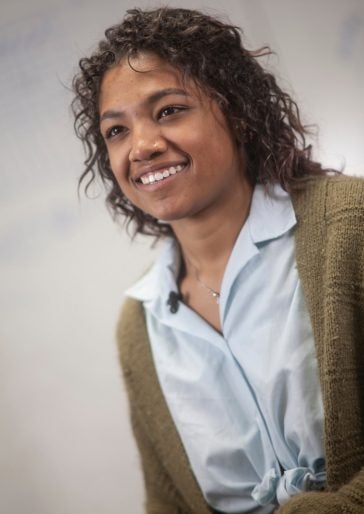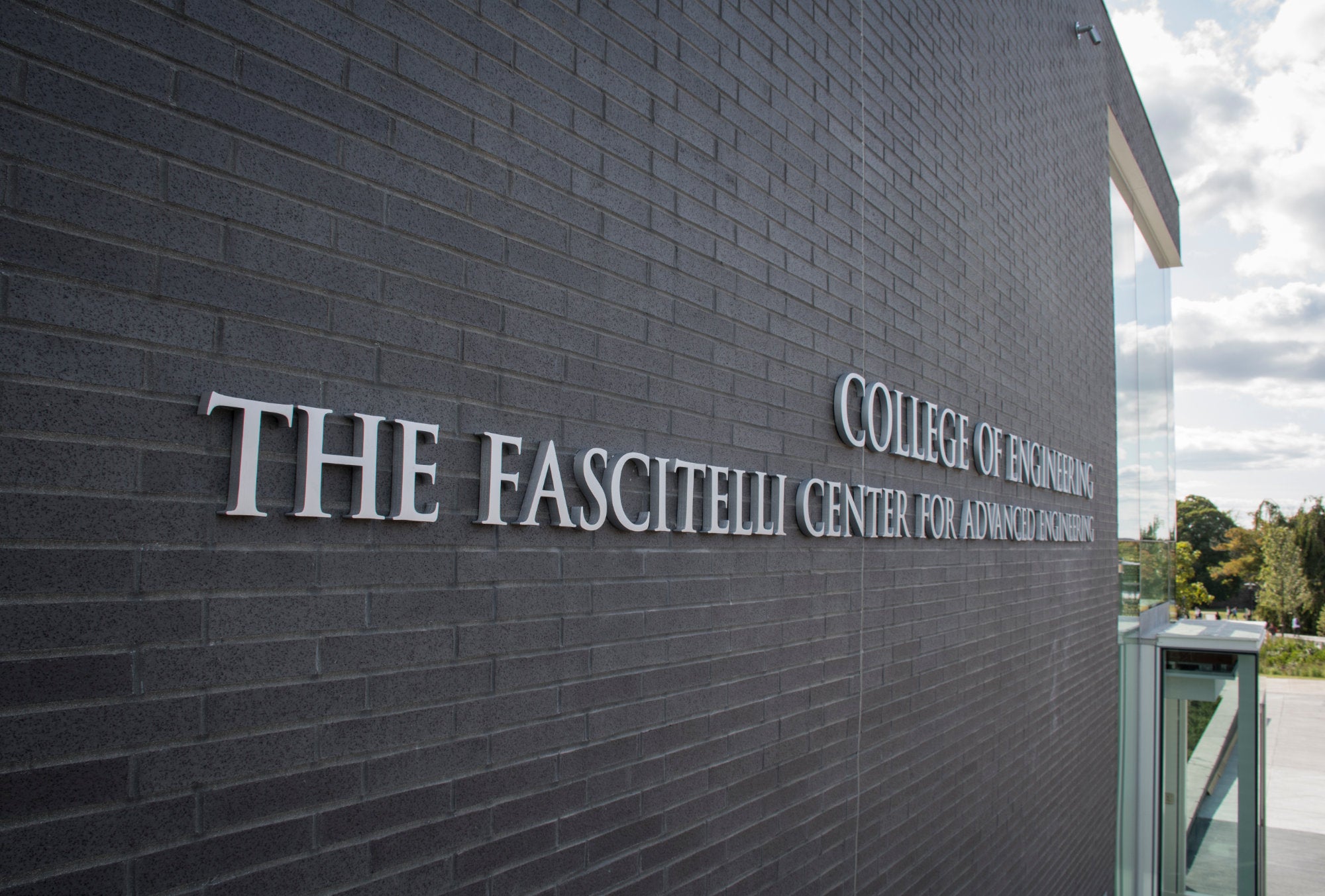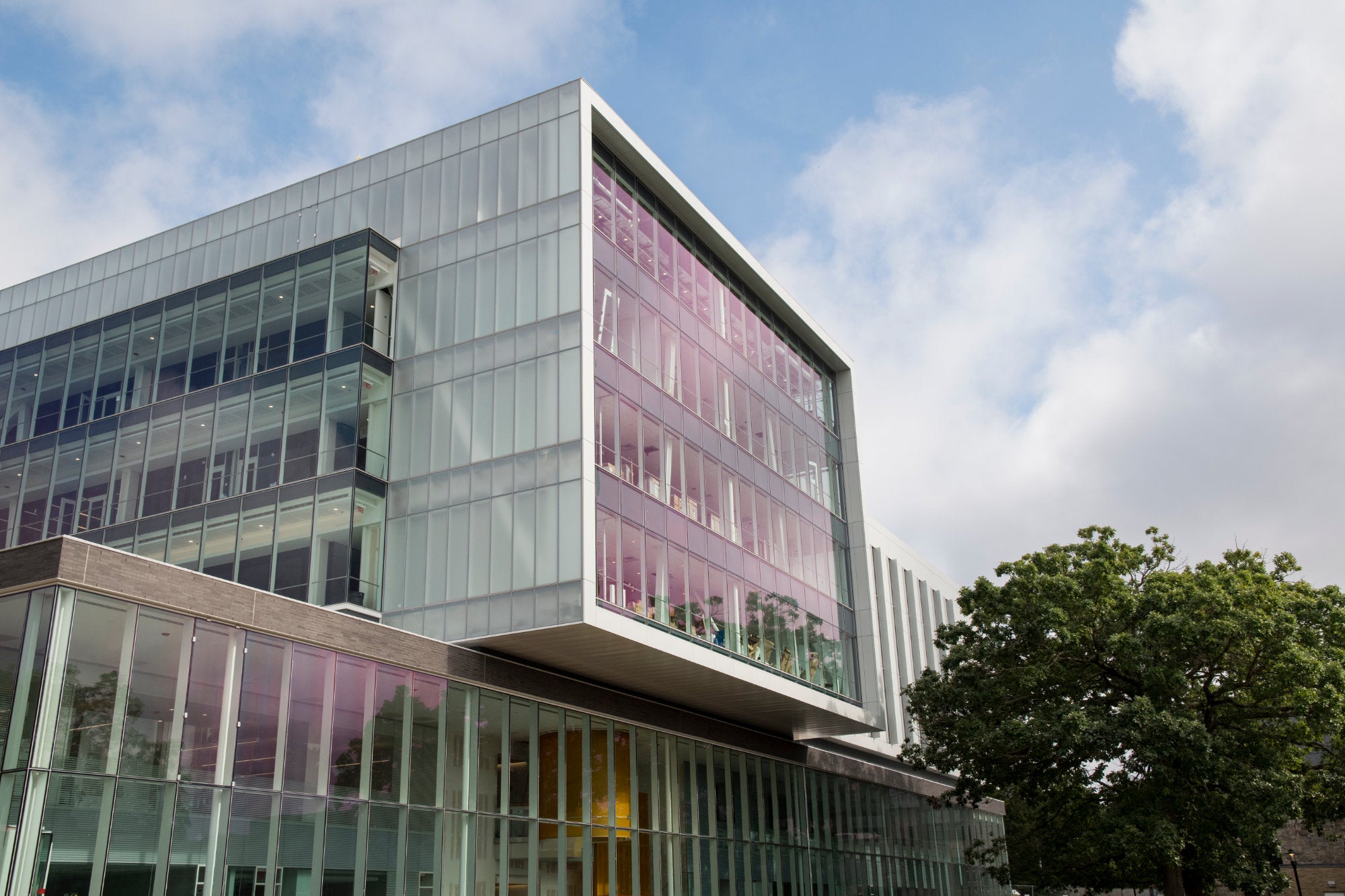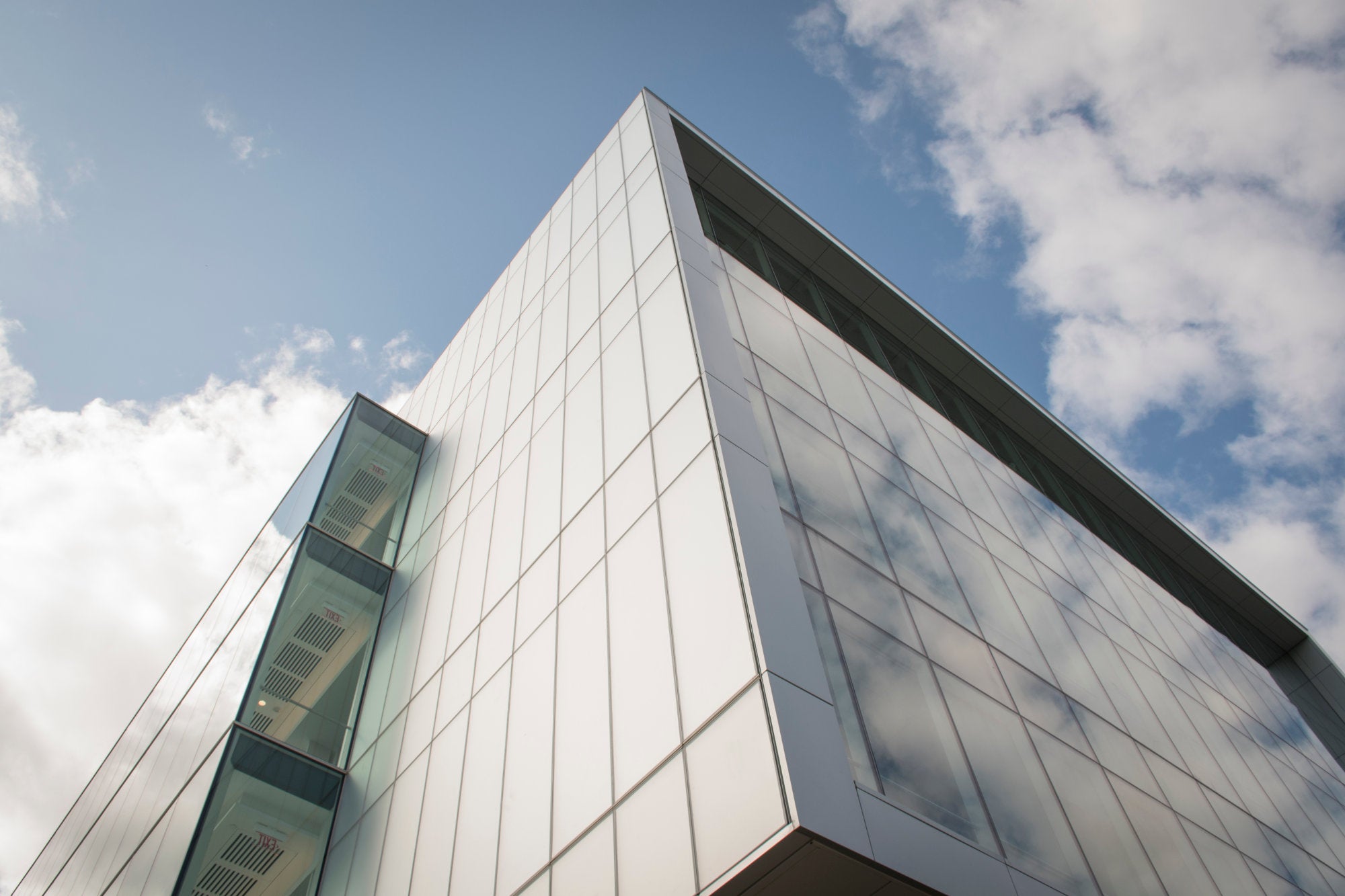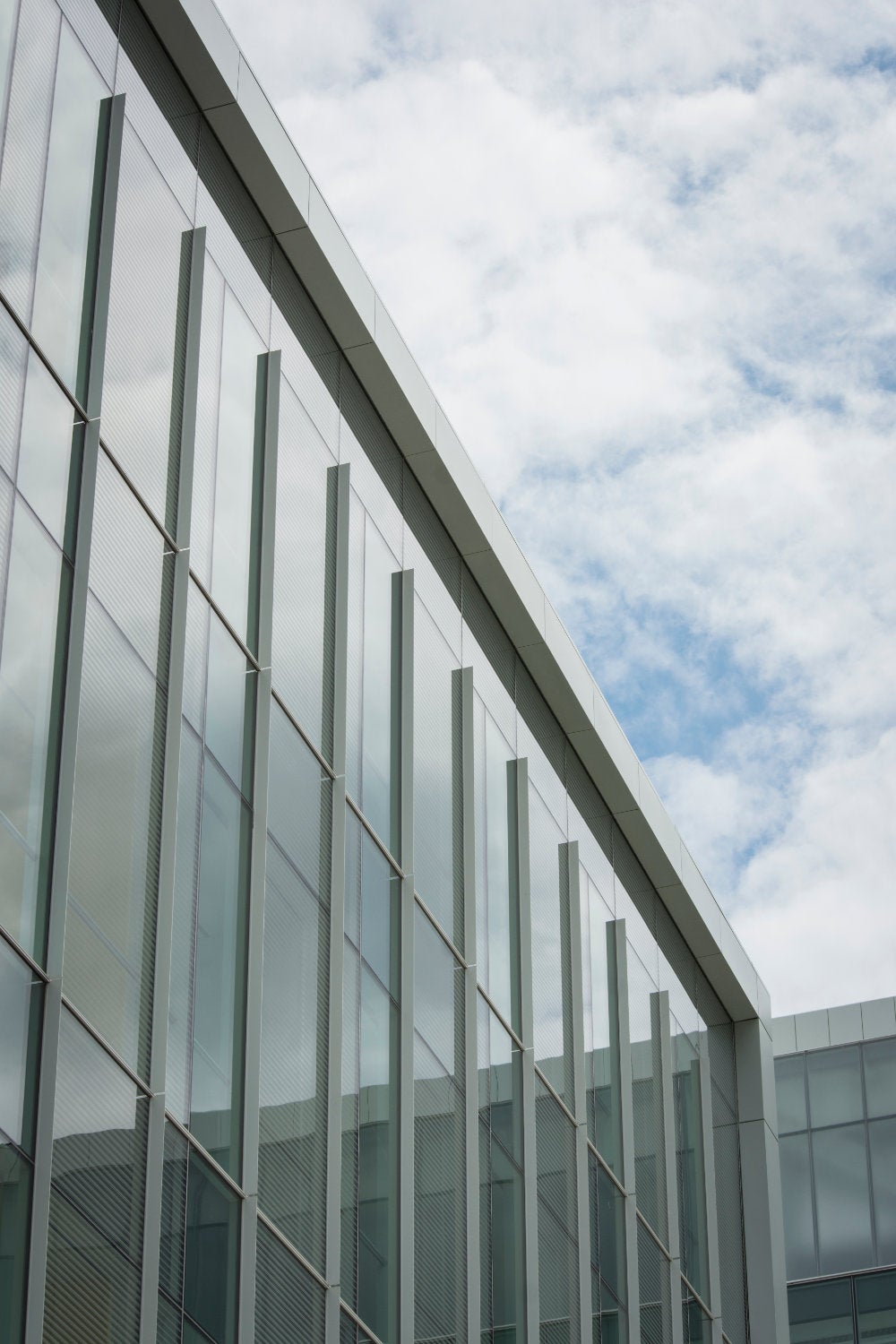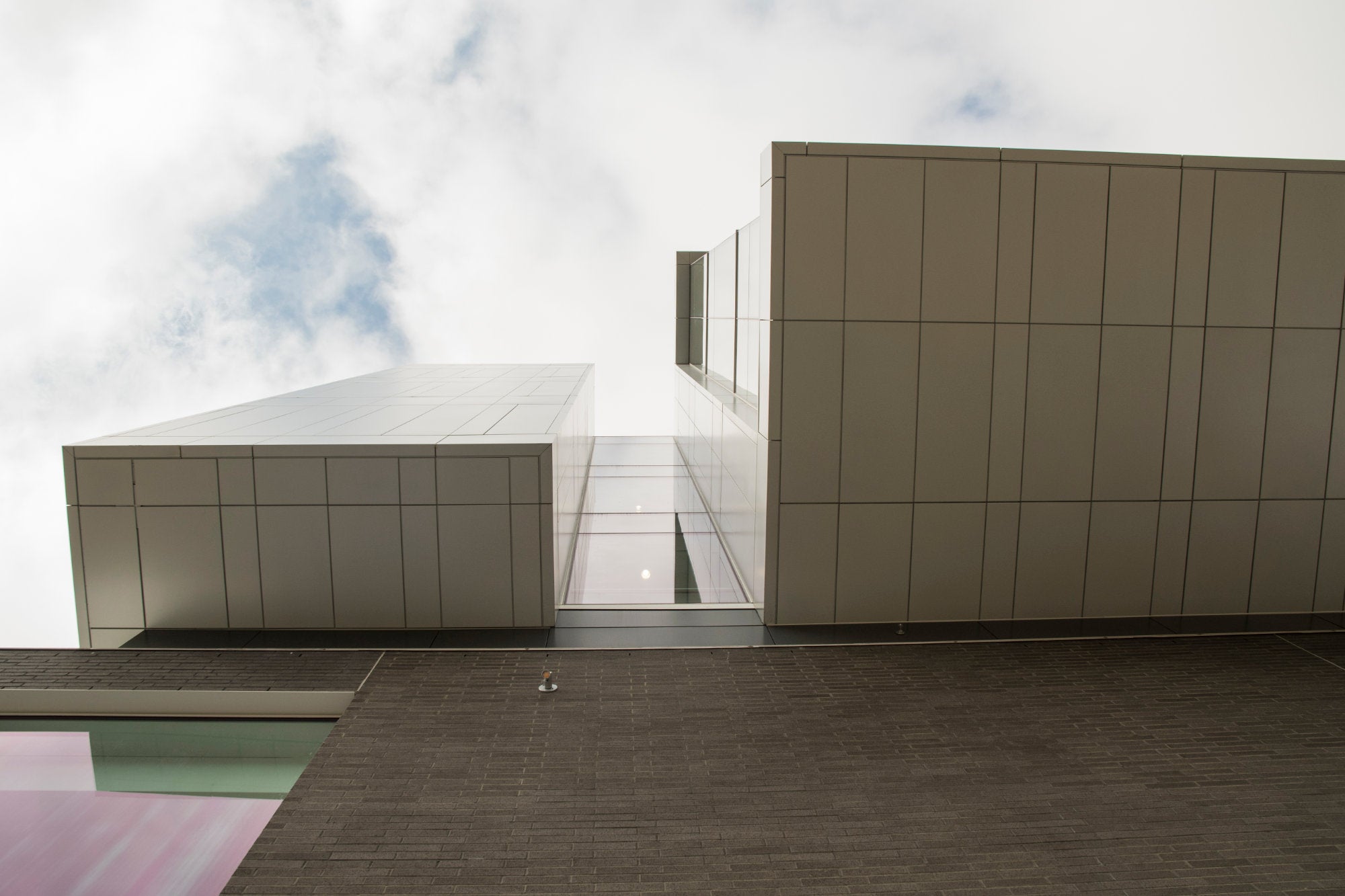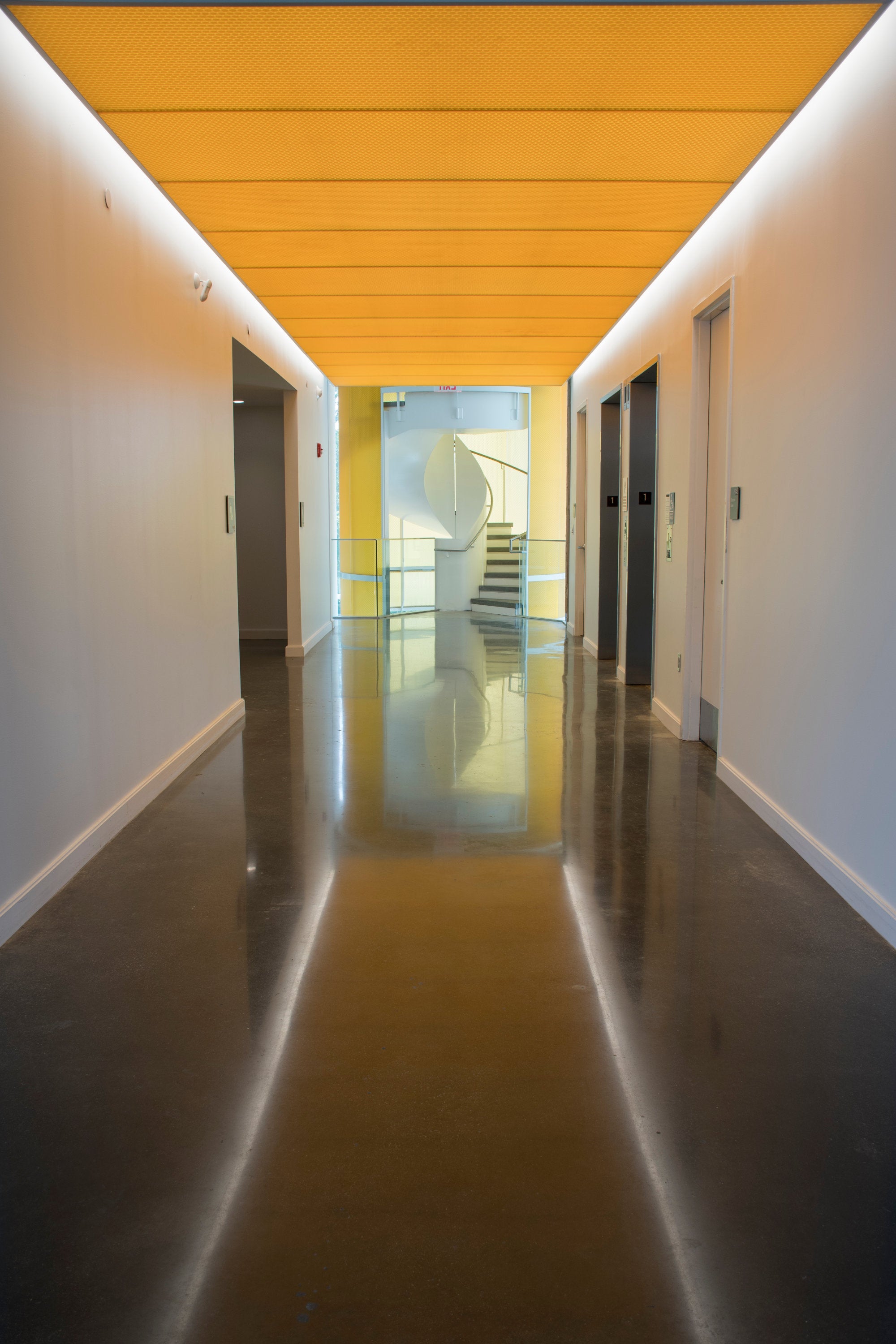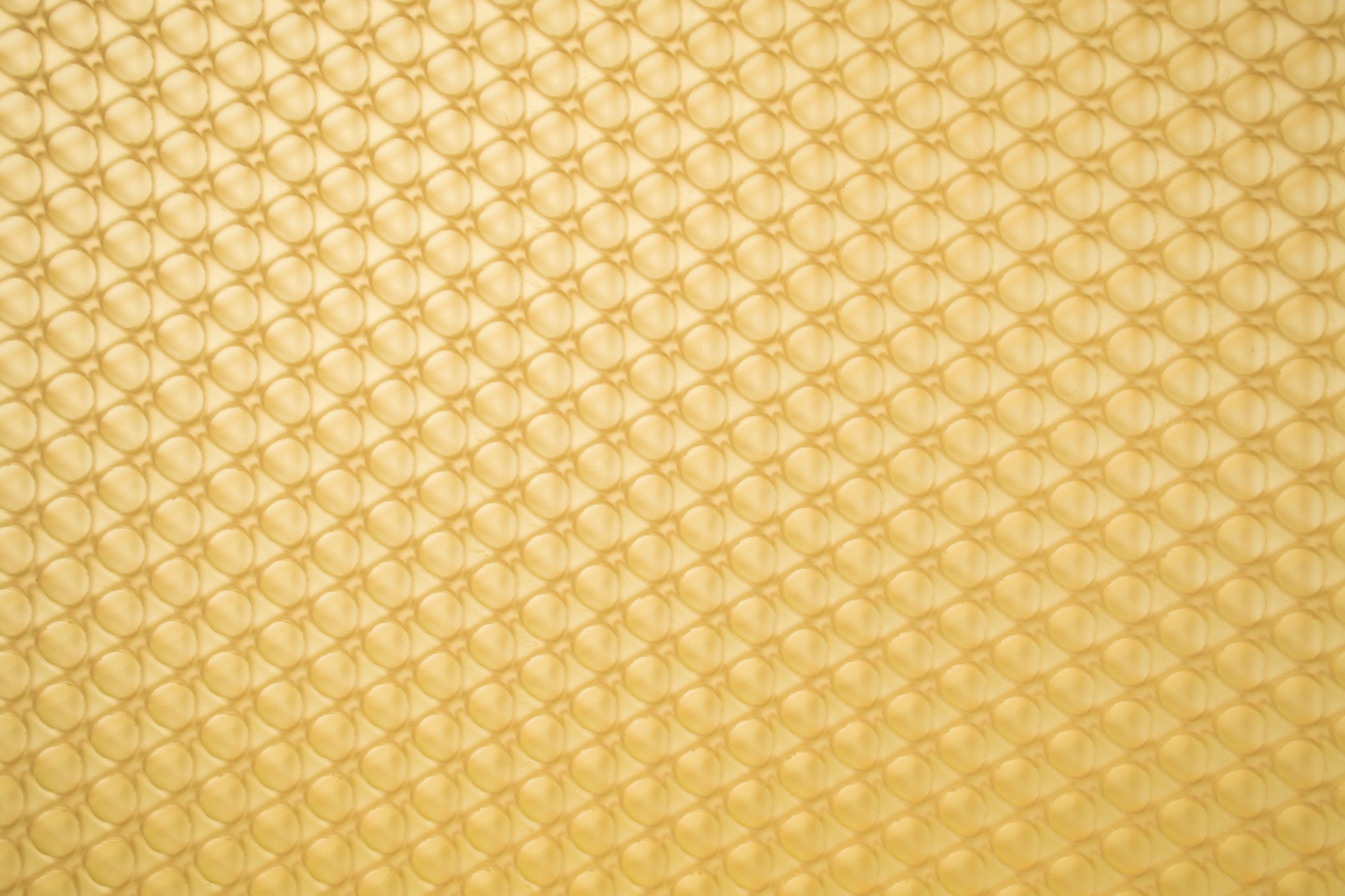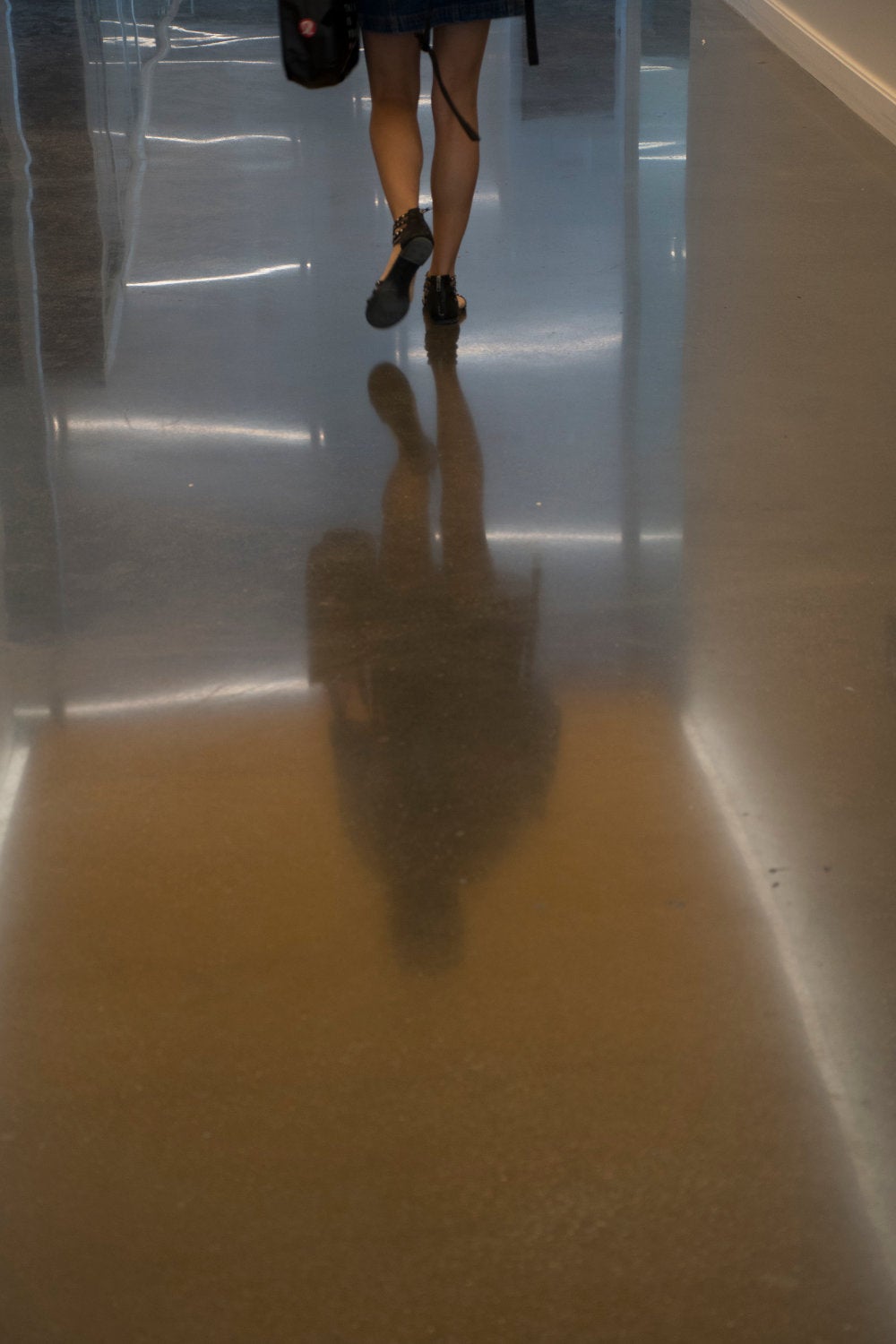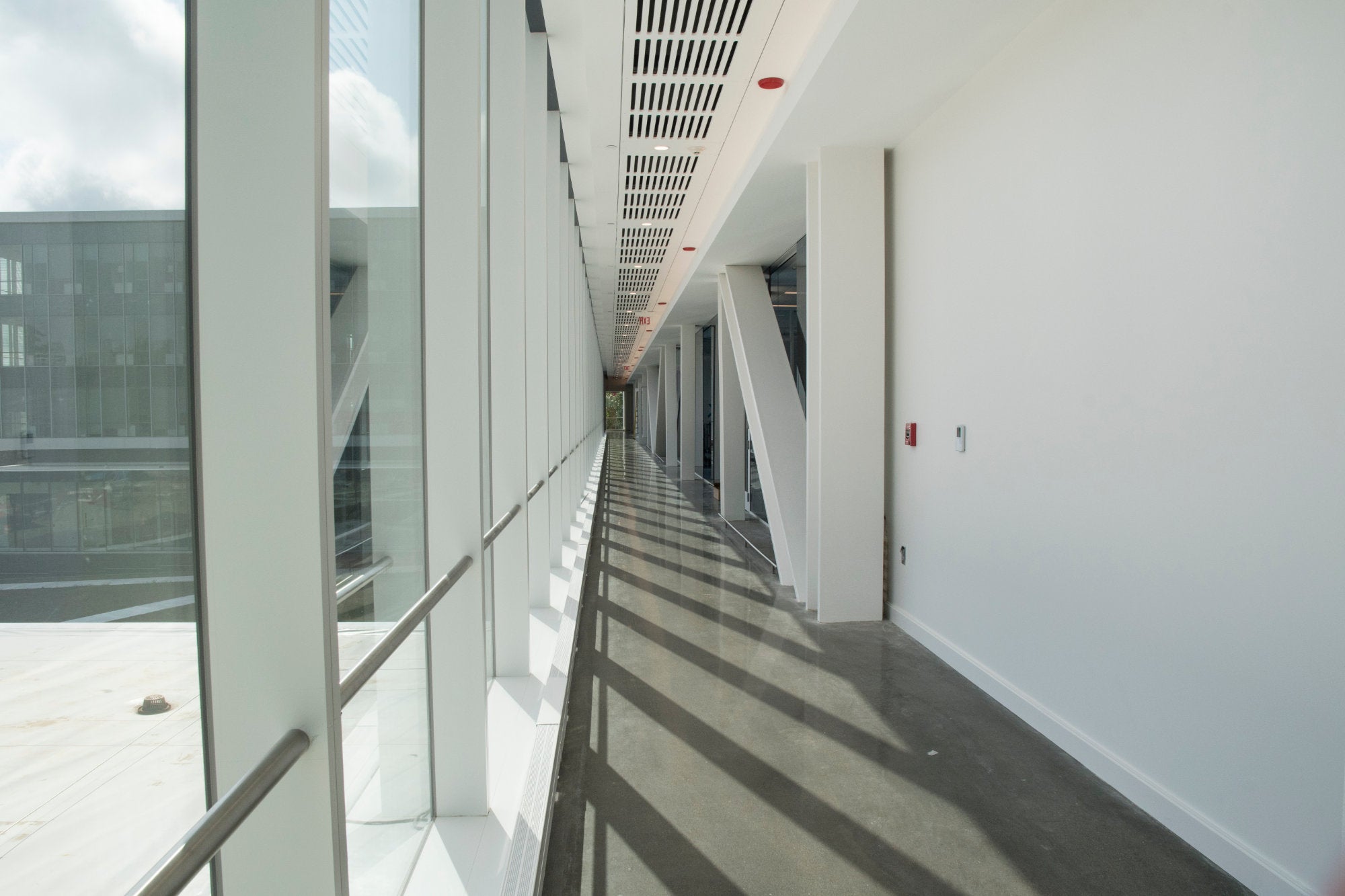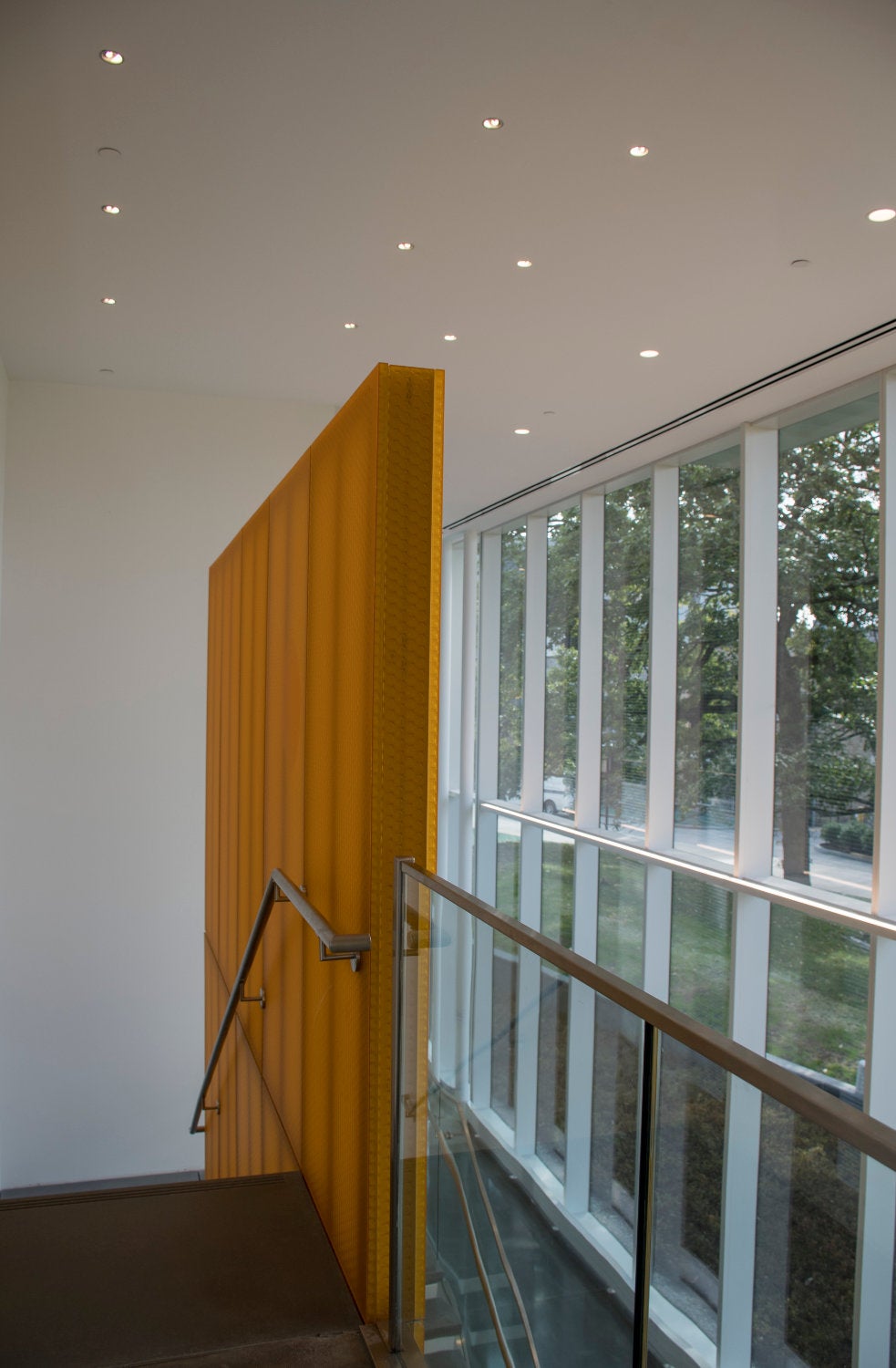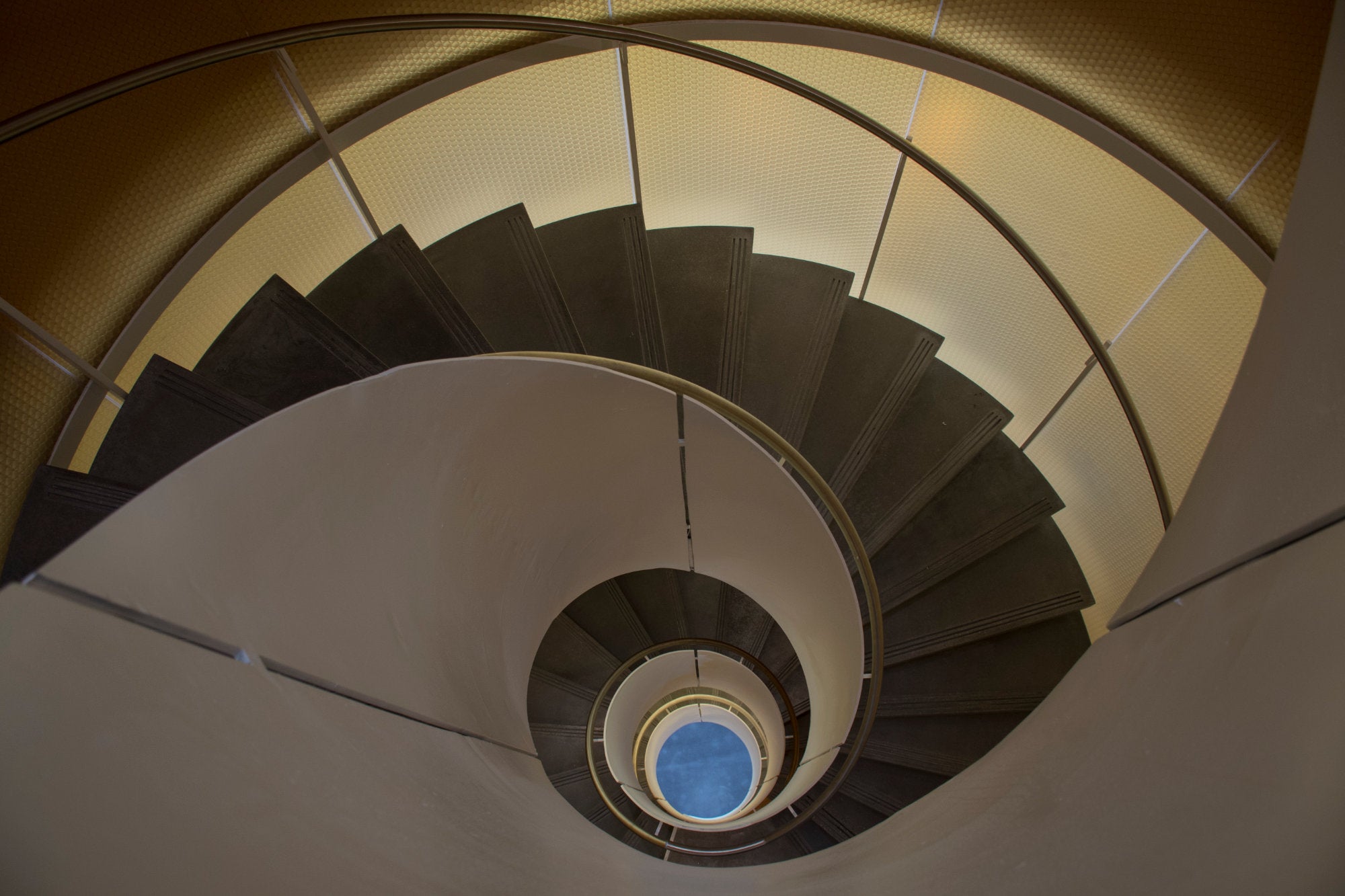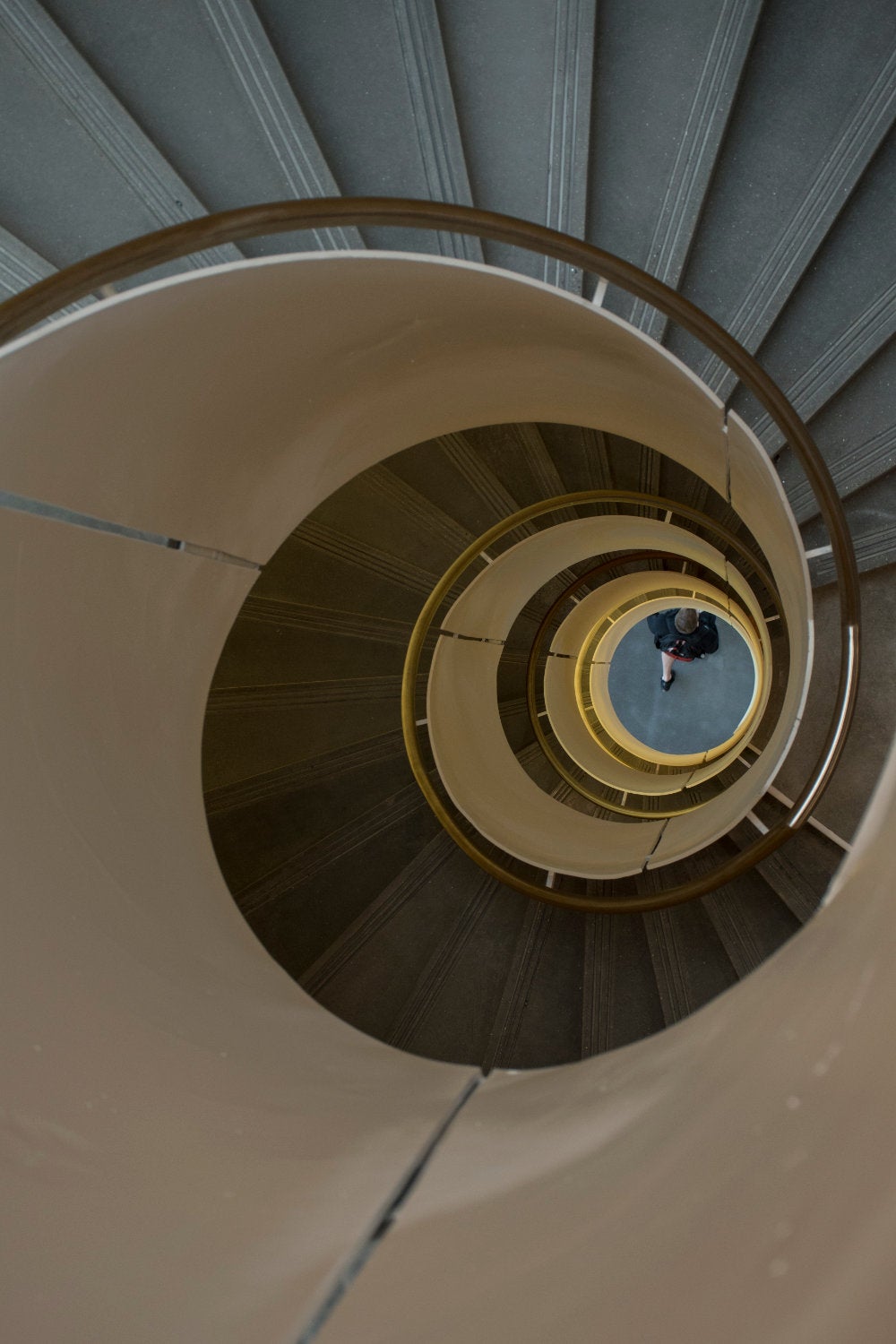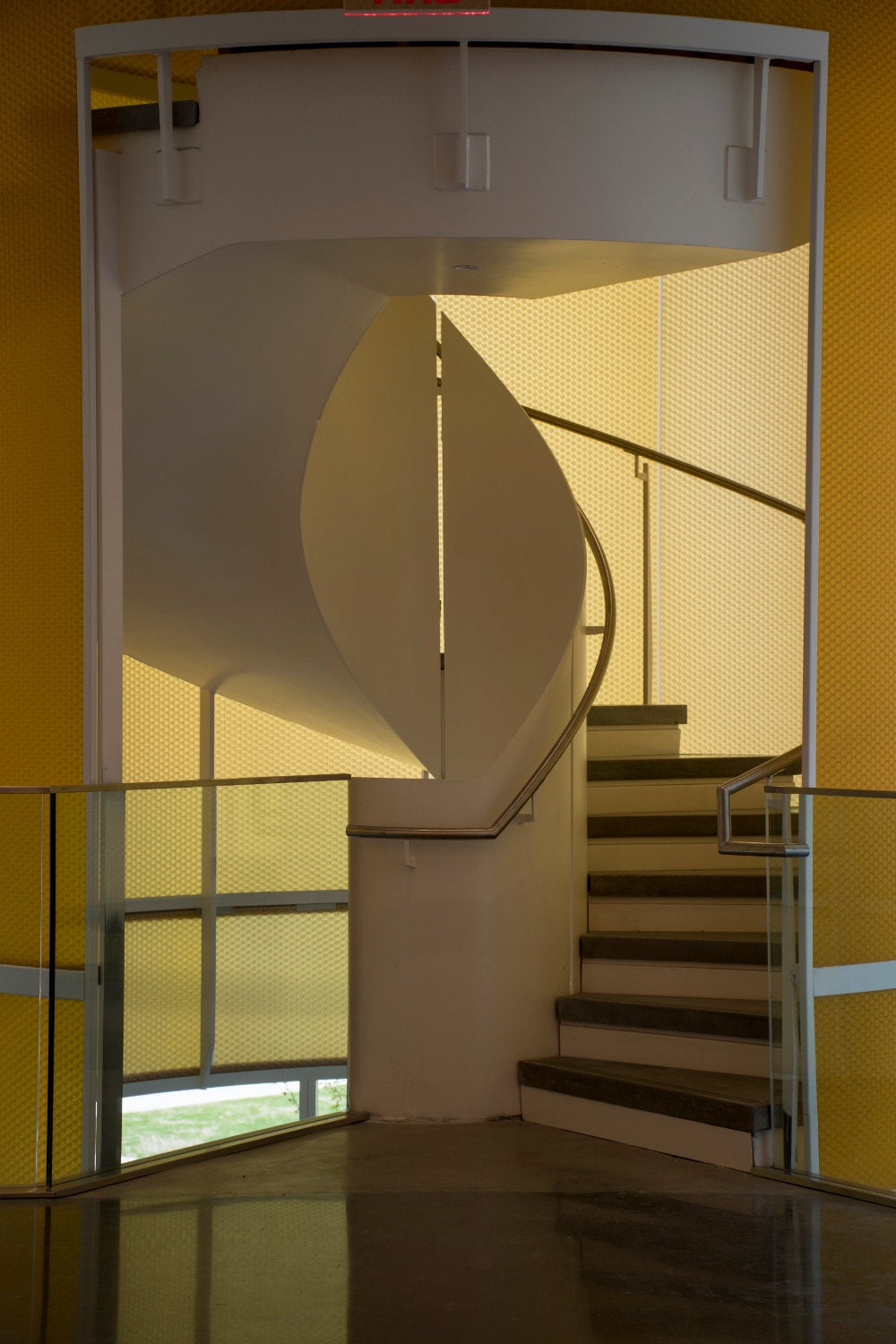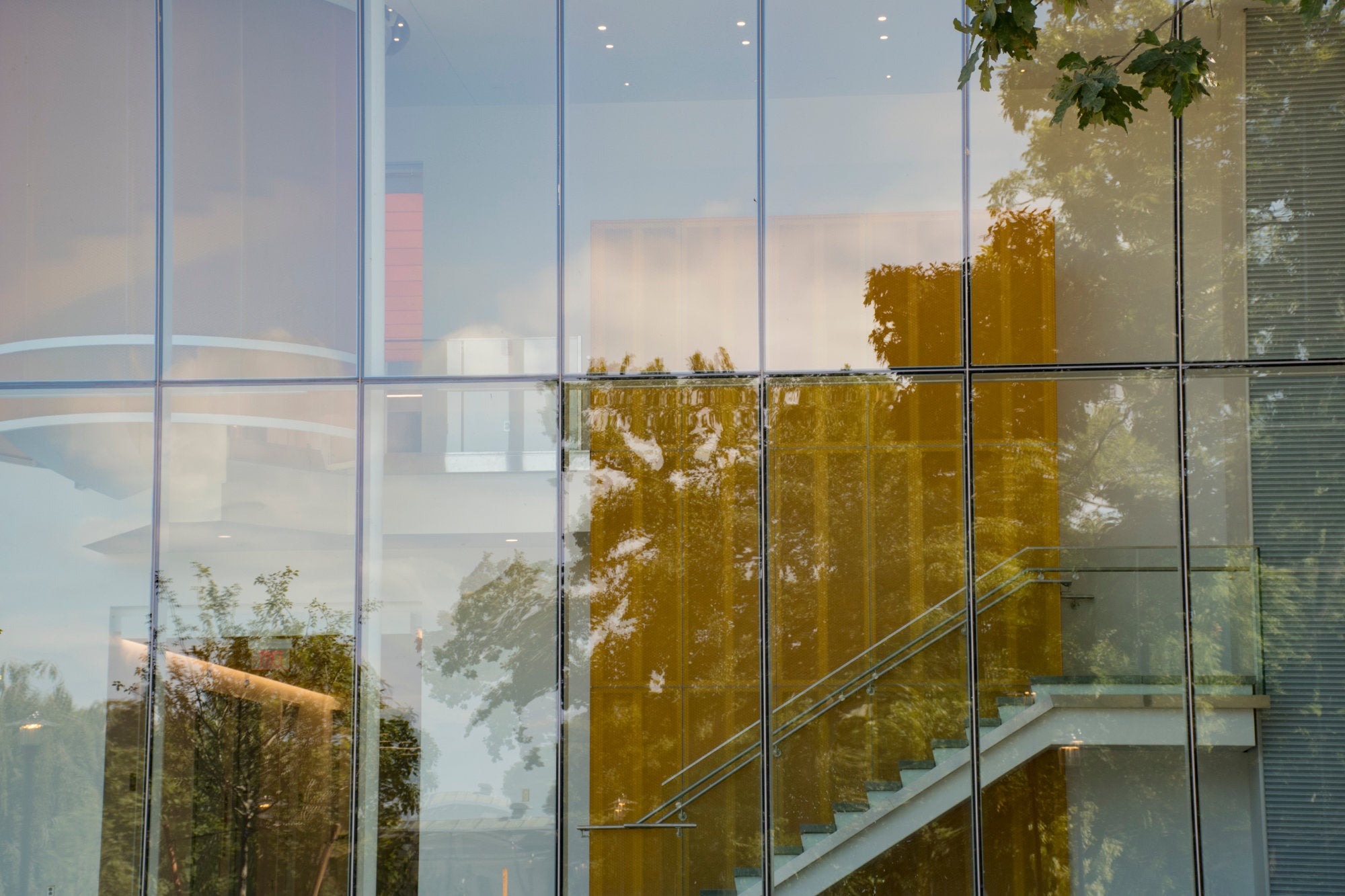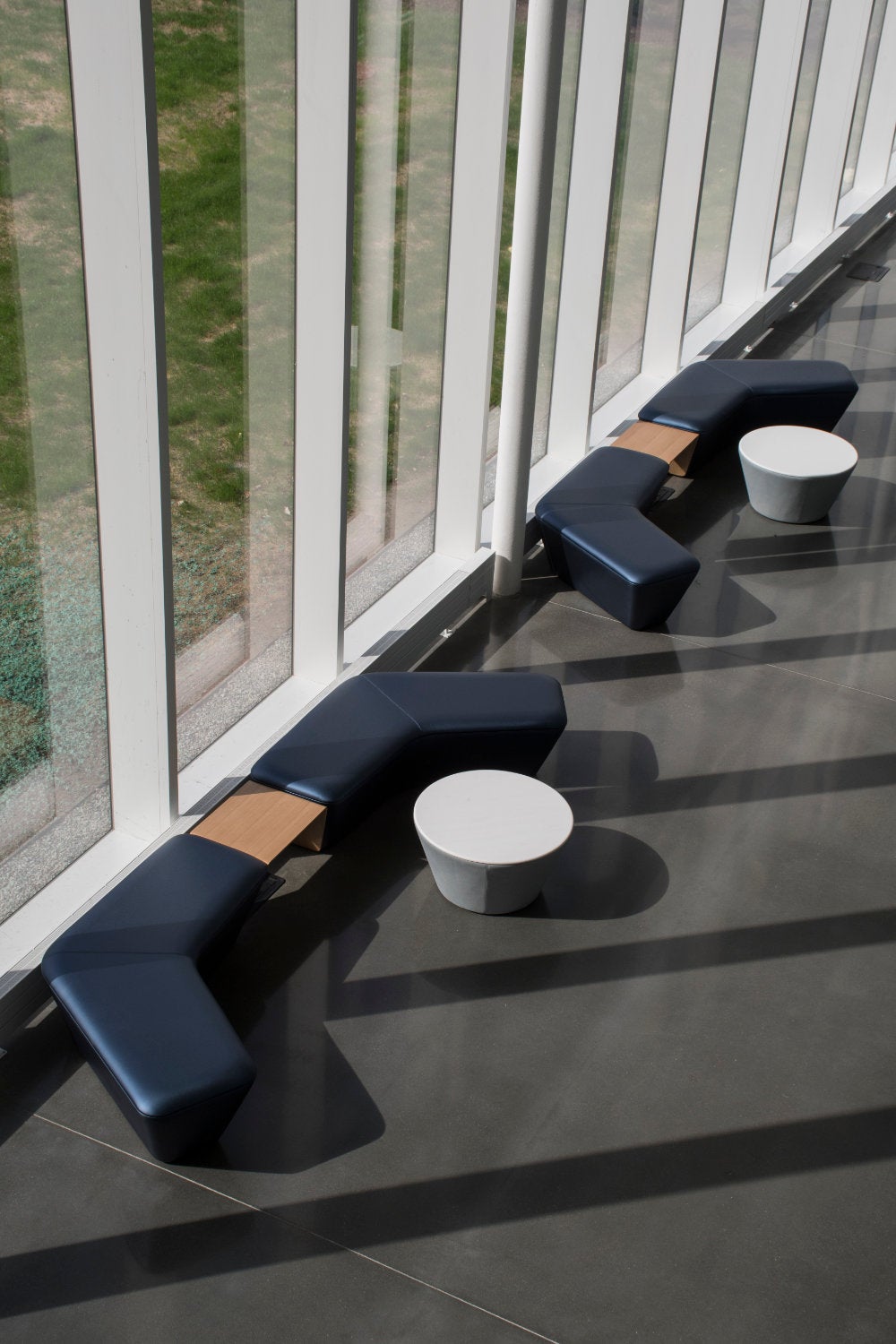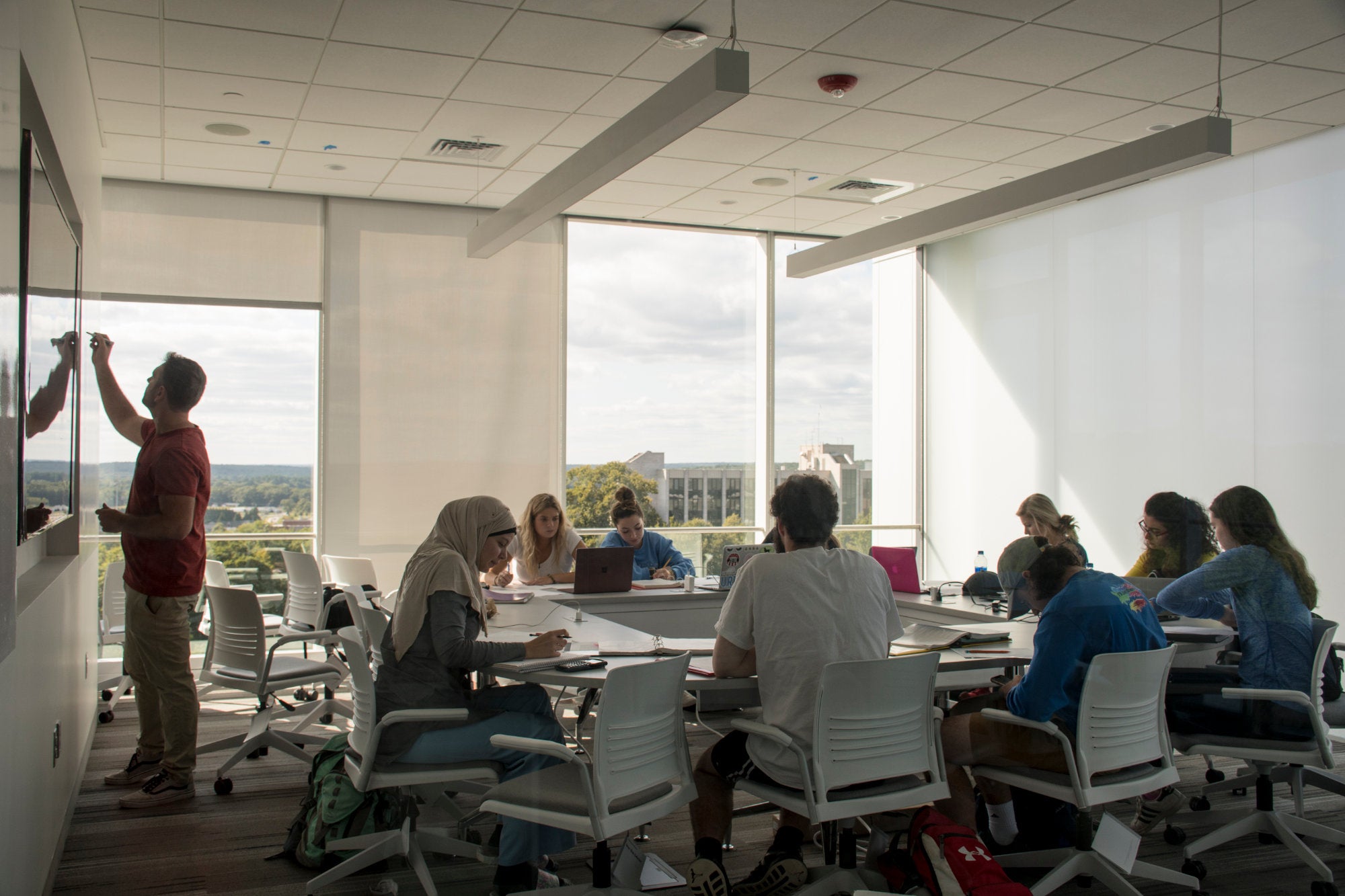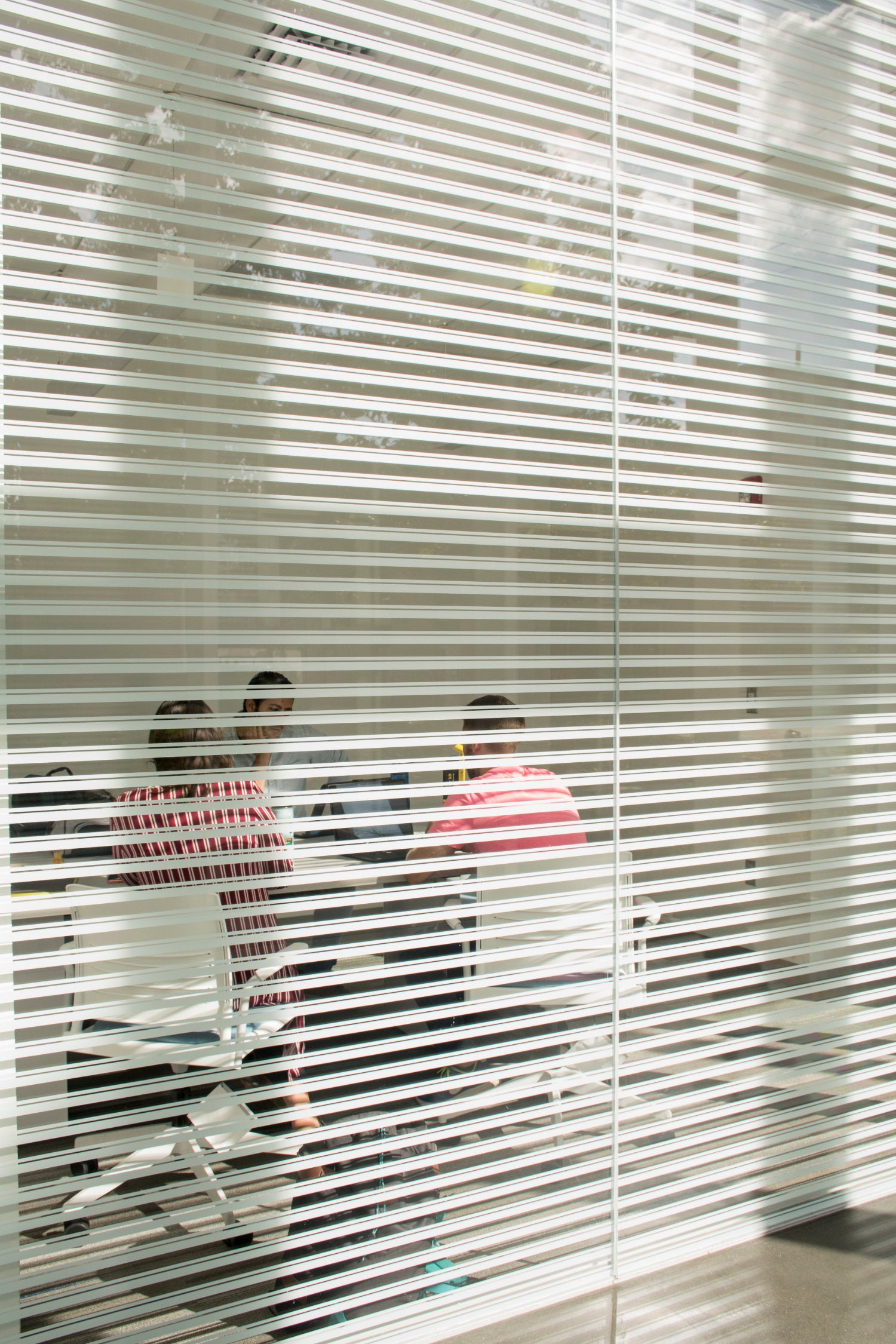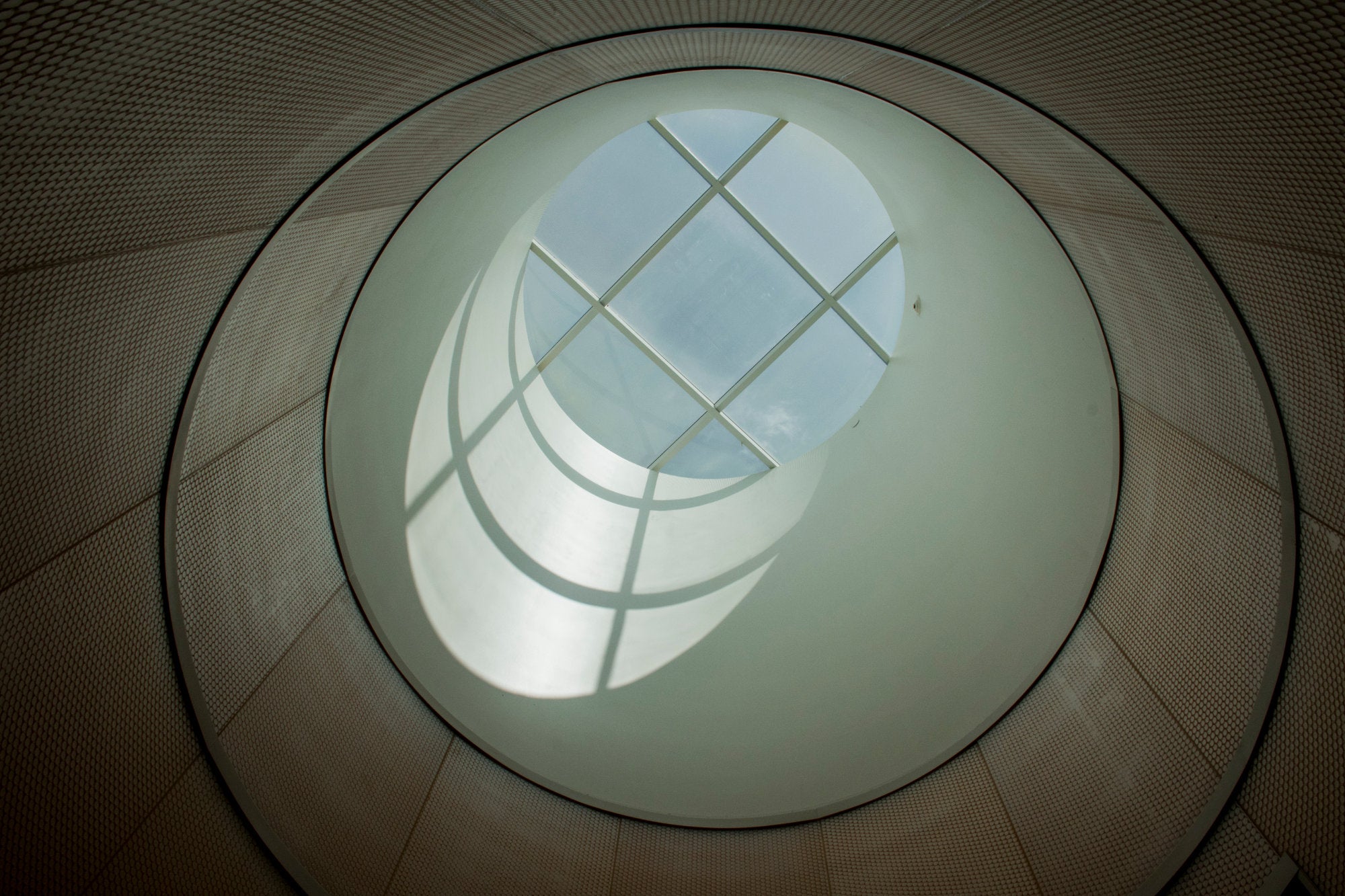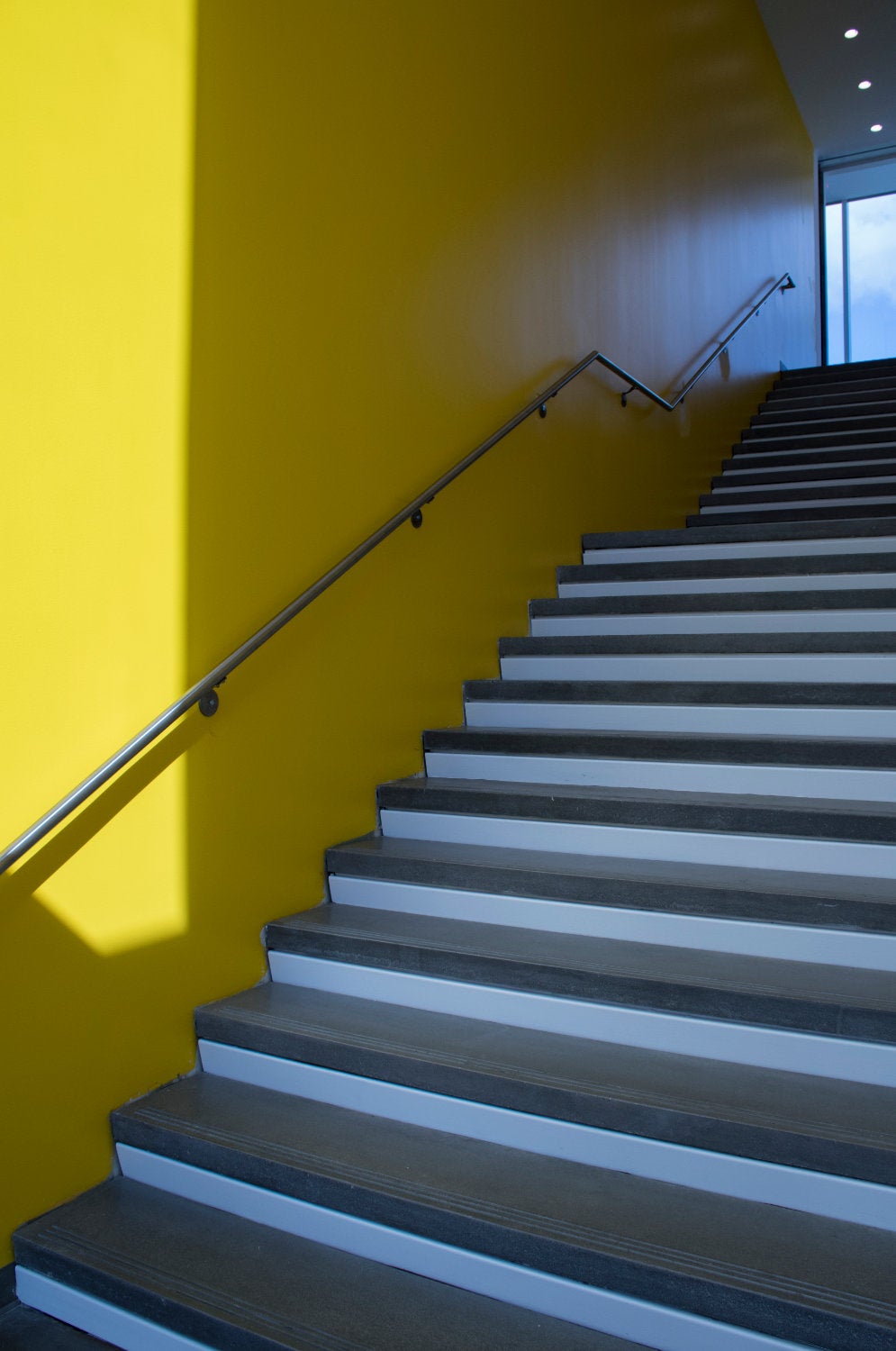A view from the fourth floor of The Fascitelli Center for Advanced Engineering, facing west: Chafee, Woodward, and Rodman Hall, and a corner of the Beaupre Center for Chemical and Forensic Sciences, reflected in the north-facing exterior glass of the building.
The largest construction project in University history, The Fascitelli Center for Advanced Engineering opened its doors this fall, bringing all the engineering disciplines together in a space that actively supports hands-on, interdisciplinary research and defies departmental silos. The center features state-of-the-art research labs, student-oriented open space, and bold, modern design–transparent, airy, and centered around common work areas.
By Janine Liberty
From the smartphone to the Large Hadron Collider to France’s Millau Viaduct, some of the world’s greatest engineering marvels have been created in the last 20 years. Rapid advances in technology and material sciences have changed not just what’s possible in engineering, but what’s imaginable. Engineers are at the center of an era defined by unprecedented technological capabilities, and their creative and practical achievements are shaping the world in entirely new ways.
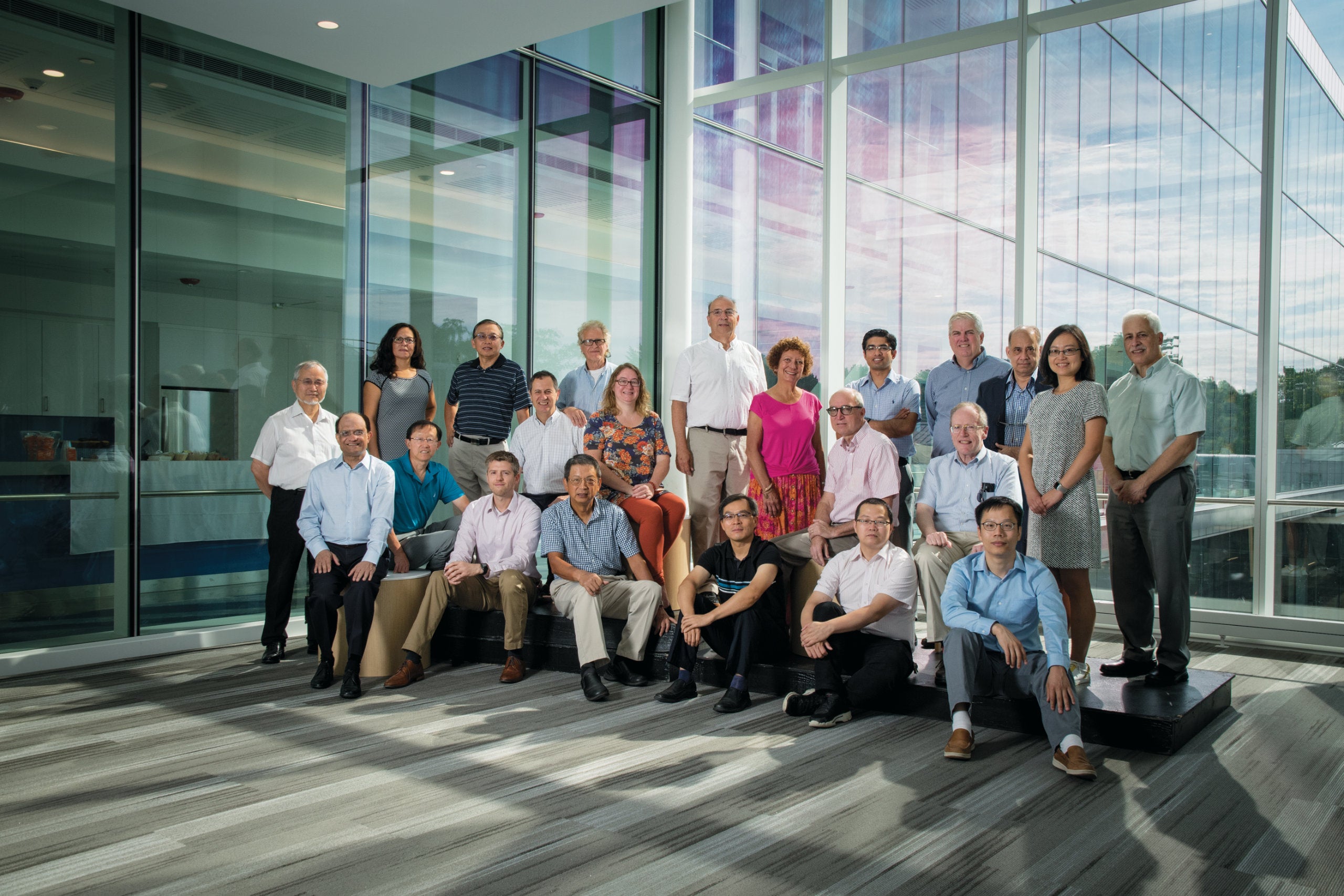
-
K. Wayne Lee
professor of civil and environmental engineering -
Harish Sunak
professor of electrical, computer, and biomedical engineering -
Vinka Oyanedel-Craver
professor of civil and environmental engineering -
Zongqin Zhang
professor of mechanical and industrial systems -
Ken Yang
professor of electrical, computer, and biomedical engineering -
Daniel Roxbury
assistant professor of chemical engineering -
Walt Besio
professor of electrical, computer, and biomedical engineering -
Jyh-Hone (Jay) Wang
professor of industrial and systems engineering -
Philip Datseris
professor of mechanical engineering -
Valerie Maier-Speredelozzi
associate professor of industrial and systems engineering -
Otto Gregory
distinguished professor of chemical engineering -
Haibo He
professor of electrical, computer, and biomedical engineering -
Mercedes Rivero-Hudec
associate professor of chemical engineering -
Peter Swaszek
professor of electrical, computer, and biomedical engineering, and associate dean of academic affairs for the College of Engineering -
Kunal Mankodiya
associate professor of electrical, computer, and biomedical engineering -
David Taggart
professor of mechanical engineering -
Bin Lee
assistant professor of electrical, computer, and biomedical engineering -
Augustus (Gus) Uht
professor-in-residence of electrical, computer, and biomedical engineering -
Chengzhi Yuan
assistant professor of mechanical, industrial, and systems engineering -
Manbir Sodhi
professor of industrial and systems engineering -
Yan (Lindsay) Sun
professor of electrical, computer, and biomedical engineering -
Richard Vaccaro
professor of electrical, computer, and biomedical engineering
Explore the image to meet the faculty.
COLLECTIVE PURPOSE
Just before classes began this fall, a group of engineering professors gathered in The Fascitelli Center for Advanced Engineering. Representing the full engineering faculty, this group comprises 22 of the college’s 74 faculty members, whose research and teaching will be shaped by the open space, transparent walls, and bridge-like architecture of the new facility.
Engineers are unique. Equal parts creative visionaries and doers, they are able to imagine technologies that will advance human potential, and construct the framework that will transform their ideas into reality. These engineers are also teachers, mentors, and guides—showing the next generation, who will be faced with some of the biggest problems the world has ever known, how to engineer solutions.
A New Space for a New Era of Research
URI’s College of Engineering is positioned to push the rapidly expanding boundaries of science and technology, and its new home, The Fascitelli Center for Advanced Engineering, is designed for this new era. With the opening of The Fascitelli Center for Advanced Engineering this fall,” says College of Engineering Dean Raymond M. Wright, “students can be educated differently, and researchers can collaborate more easily across disciplines.”
“This new facility will stimulate collaborative, multidisciplinary learning and research. It will lead to discoveries that we cannot even imagine today.”
–URI President David M. Dooley
“Increasingly, our engineering students and faculty are not only working in interdisciplinary teams within the college, but with students and faculty from across the University in oceanography, health, pharmacy, chemistry, computer science, and business as well as companies and corporations around the state, region, and the world,” URI President David M. Dooley says.
During preliminary meetings with the project’s principal architect, Terry Steelman, of the firm Ballinger of Philadelphia, Wright explained that he wanted to bring faculty together through research areas, not departments or disciplines. “One thing we know for sure is when we bring people together to solve challenges, it gets done,” says Wright.
The college will be organized around critical interdisciplinary research themes that address some of the biggest challenges the world faces: alternative energy, nanotechnology, robotics, cybersecurity, water for the world, biomedical technology, advanced materials and structures, and sensors and instrumentation.
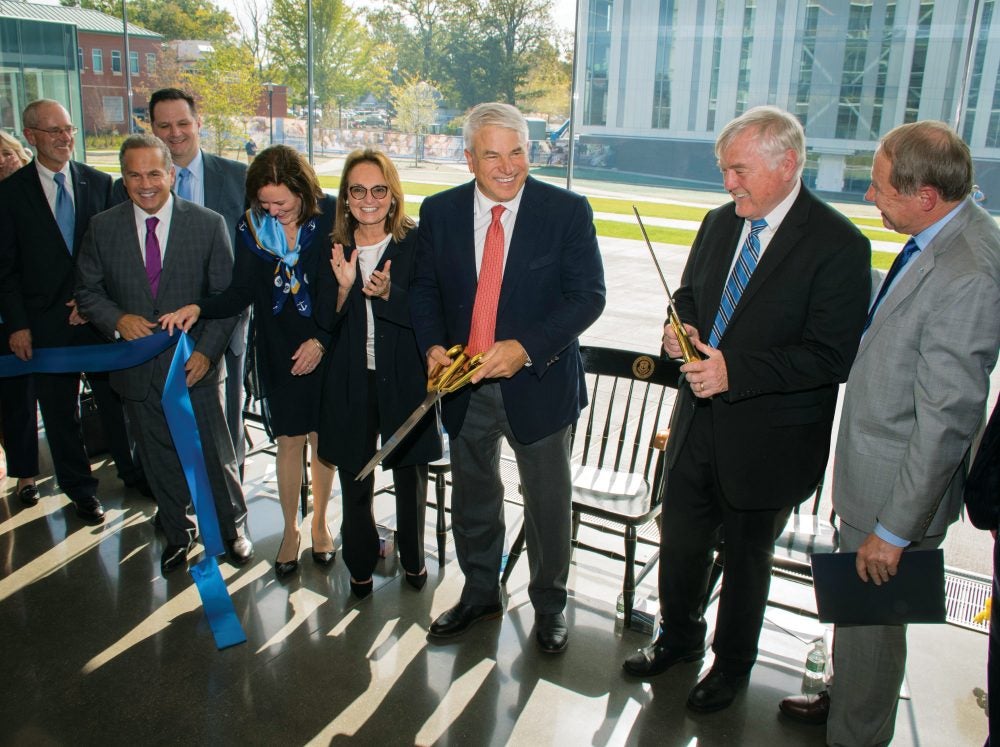
The Fascitelli Center will support and encourage this interdisciplinary research by physically locating faculty from different disciplines near one another and adjacent to common research and meeting spaces. “Almost nothing in engineering anymore exists solely within a single discipline,” says Steelman. “This building is designed not just to advocate for, but to stimulate interdisciplinary discovery, so students can be educated differently, and researchers can collaborate across disciplines.”
“When the engineering disciplines combine, the sum is greater than its parts. URI engineering is building the future.”
–Dean Raymond M. Wright
“Our faculty are designing and building the infrastructure modern society relies on; finding innovative ways to harness energy from our sun, ocean, and even highways; building new medical diagnostic methods and devices; and racing to ensure every man, woman, and child has access to clean, safe water,” says Wright.
“This new facility will stimulate collaborative, multidisciplinary learning and research. It will lead to discoveries that we cannot even imagine today,” Dooley adds.
The new building was funded by two Rhode Island voter-approved bond issues, as well as private gift commitments from corporations including Toray Plastics (America), Inc.; FM Global; Taco; Hexagon; and Shimadzu; and from individual donors, including a $10 million gift from College of Engineering alumnus Michael D. Fascitelli ‘78, Hon. ‘08, and his wife, Elizabeth Fascitelli.
Learning Through Hands-On Research and Fieldwork
Working in robotics is like the Wild West in terms of the opportunities it presents,” says engineering student Robin Hall ‘20. “It’s always innovative, always changing, and there is always something new to work on.” Hall sits in the Intelligent Control and Robotics Lab surrounded by unmanned aerial vehicles (UAVs), robots, spare wires, and computers.
Situated on the fourth floor of the new engineering building, the robotics lab opens up to an expanse of glass that encloses the exterior hallway. From inside, you can look out over the northern edge of the Kingston Campus to the woodlands beyond. Hawks soar above the distant treetops, in effortless flight, while research teams inside devise robotic systems capable of agile, aerial movement.
“Working in robotics is like the Wild West in terms of the opportunities it presents.”
–Robin Hall ’20
This year, Hall has an independent research grant to develop a wall-traversing drone. “My idea employs a four-propeller UAV surrounded by an external cage that can rotate independently from the internal body of the robot. The cage will protect the vehicle and maintain stability.” Working with existing drone and cage designs, Hall’s innovation is to fix two axes and add a motor to the third axis to control the movement. “The quadcopter will behave like a wheel, rolling laterally against a wall surface.”
He’ll work with Paolo Stegagno, assistant professor of electrical, computer, and biomedical engineering, as his grant adviser. “As he designs and tests his UAV, Robin will gain advanced knowledge of control systems,” says Stegagno.
More research involvement–such as Hall’s–at the undergraduate level is important to the college; it means higher-quality senior projects, better internships, and more opportunities for students at all levels to learn from one another. Senior capstone projects are team-oriented and industry-driven, focusing on real-world challenges companies bring in for senior-year students to work on over the course of the academic year.
Making the capstone projects highly visible is meant not only to benefit students, but to attract industry. The projects are already an important point of entry for industry partners, having reliably translated to employment for graduates as well as research and economic partnerships with the University.
College of Engineering alumnus W. Lewis Collier, M.S. ‘86, Ph.D. ‘14, rapid engineering and prototype systems engineering manager for the MIL Corporation, and former technical director at Navmar Applied Sciences Corporation, supervised URI engineering students doing capstone projects at SRI International. He says URI’s capstone program “offers a valuable opportunity for students to apply and hone their engineering skills and learn about real-world problems and how engineers operate in the field.” Adds Collier, the program “is also important to the University’s mission to provide educated workers for Rhode Island businesses.”
Photo Gallery
A New Space for a New Era of Research
Great design is achieved through a balance of opposites. This 190,000-square-foot, five-story engineering building is a tour de force of design.
During the day, light streams throughout the enormous expanses of open space, constantly shifting in color, shadow, and intensity as it passes through surfaces of varying opacity. This effect is balanced by the density and stability of the building’s metal truss support system–which eliminates the need for interior support columns and allows for uninterrupted, open interiors–and sleek concrete floors.
“The glass of the building is both a metaphor and a physical manifestation of transparency and collaboration.”
—Dean Raymond M. Wright
The trusses, which span more than 150 feet of open space inside and are visible from the exterior of the building, are like those used for bridges, giving the building a bridge-like appearance, which emphasizes its physical siting between the older, humanities-focused buildings in the center of the Kingston Campus and the newer, science and technology-focused buildings on the north edge of campus.
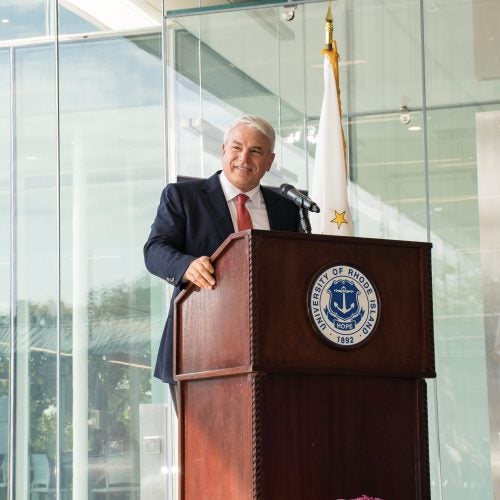
In the new building, capstones will be a significant and highly visible part of the activity. More importantly, points out Wright, students from different research themes will be working in the same space. “You’ll have civil engineering and mechanical and biomedical capstone projects happening side by side.” In the building’s design, the Ballinger team combined the majority of the teaching environments on the first floors, so that students will be exposed to the interdisciplinary nature of the building.
“The quad level is a remarkable place,” says Wright. “We want our students to recognize that it’s their home. There are no faculty offices or research offices on that floor. It’s all about showcasing the hands-on aspects of engineering and building a creative atmosphere for students.”
Great architecture must also balance the experience of the individual with a collective purpose. Fascitelli credits Wright’s vision of bringing the college’s departments together as the driving force behind the building design. “Science as a whole has become so much more interactive, and the world is changing at such a rapid pace,” says Fascitelli. “You really need that cooperation between disciplines.”
Says Wright, “The glass of the building is both a metaphor and a physical manifestation of transparency and collaboration.”
“There’s nothing like this building in our portfolio. It’s unique to URI and I’m really proud of that,” says Steelman, adding that the center is “one of the most provocative and technologically advanced engineering buildings in the country.”
Hall is inspired by the new engineering space. “Being able to work in this space is an amazing upgrade,” he says. “It’s like a temple. It feels like you have the opportunity to do anything here.”•
College of Engineering at a Glance
The Fascitelli Center for Advanced Engineering not only supports the college’s advanced research and innovative teaching, but also its continued growth and achievement.
URI’s flagship dual-degree, International Engineering Program (IEP) was the first such program in the country when it launched 32 years ago.
Over 90% of URI’s engineering grads are employed or in graduate school within six months of graduation.
Insatiable Curiosity
Vanessa Kamara ’21 thinks engineering has a lot to learn from nature.
“I’m a curious person,” says biomedical engineering student Vanessa Kamara. “I have lots of questions.”
She wants to find ways to improve healthcare by drawing inspiration from nature. “I’ve always been interested in health care, and I want to learn how to make it better,” she says. “There are so many things we don’t know. I have textbooks that basically say, ‘This is what this thing is called, but we don’t really know what it does. That’s all we have for you.’”
Kamara isn’t satisfied with that. She wants to do research that leads to answers, explanations, and solutions.
“You know lactic acid, the stuff that, when you run or work out, makes your legs hurt?” she asks. “Well, I was working with a grad student on a project that takes lactic acid strands and layers them on a substrate to create a biodegradable sensor.” The sensor is intended for use in the shoes of Parkinson’s patients to track their motions; after use, it could safely degrade without harming the environment. “It would be eco-friendly and allow us to collect data.”
